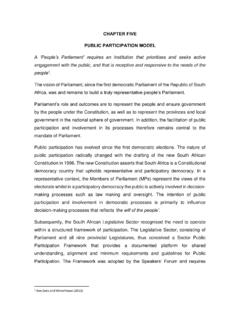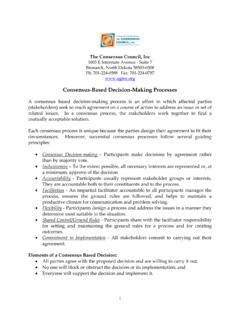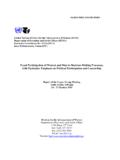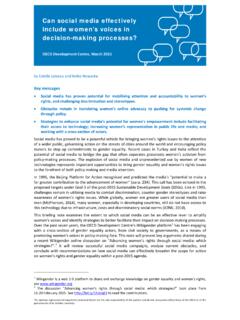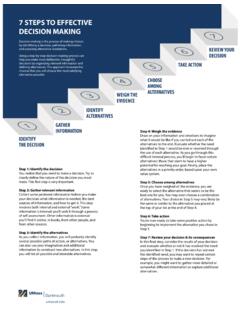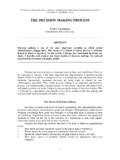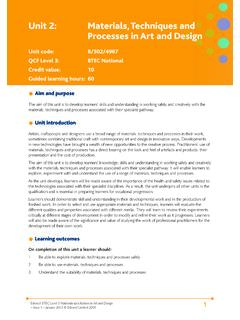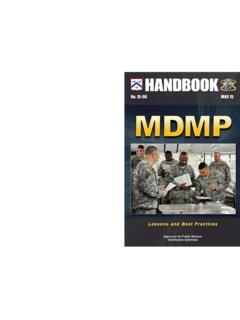Transcription of A Need to Know: An Ethical Decision-Making Model for ...
1 40 Volume XXXIX, Number 1, 2008 The Journal of Research Administration The Journal of Research Administration Volume XXXIX, Number 1, 2008 41 ArticlesA Need to Know: An Ethical Decision-Making Model for Research AdministratorsSarah Hope Lincoln, BAStockdale Center for Ethical LeadershipUnited States Naval Academy112 Cooper RoadAnnapolis, MD 21402 Tel: (410) 293-6088 Email: Elizabeth K. Holmes, PhDStockdale Center for Ethical LeadershipUnited States Naval Academy112 Cooper RoadAnnapolis, MD 21402 Tel: (410) 293-6088 Email: NoteThis paper was presented at the 2007 Symposium at the annual October meeting of the Society of Research Administrators International in Nashville, Tennessee. The authors are solely responsible for the contents of this article. The contents do not reflect the policy of the Department of Navy, Department of Defense, or the Government. Please address all correspondence concerning this article to Elizabeth K.
2 Holmes, , Stockdale Center for Ethical Leadership, 112 Cooper Road, Annapolis, Maryland, 21402. E-mail: faced with a morally charged situation, individuals engage in an Ethical Decision-Making process to resolve the Ethical dilemma. This paper outlines a Model that describes the steps in the Ethical Decision-Making process and identifies situational factors, collectively termed moral intensity, which may influence this process. The use of a case study, presenting an Ethical dilemma relevant for professionals, offers an opportunity to apply the Ethical Decision-Making Model . This Model can be used as a teaching and training tool to enhance research administrators professional development in research : Ethical decision making , moral intensity, Ethical professional developmentIntroductionThe ability to work through and resolve Ethical dilemmas is an important skill for any professional. The multi-faceted work of research administrators forces them to deal with a multiplicity of dilemmas related to research ethics.
3 These dilemmas can arise in any of the areas or allied disciplines related to research administration, such as financial stewardship, operations, human resources management, sponsored projects oversight, strategic planning, research law, 42 Volume XXXIX, Number 1, 2008 The Journal of Research Administration development activities, standards for the responsible conduct of research, and human subjects protection. The ability to tackle Ethical dilemmas to uphold the Ethical integrity of research and ensure regulatory compliance is critical for professional research administrators on all levels, including executives, middle managers, and technical or support staff. Yet, as individuals join the research administration profession from diverse backgrounds and previous experiences, their exposure to research ethics also varies. Recognizing that each research administrator brings different perspectives and experiences to Ethical situations, it is important that research administrators of all professional levels receive clear, effective training for dealing with Ethical dilemmas.
4 Literature ReviewRushworth Kidder, founder of the Institute for Global Ethics, describes a true Ethical dilemma as a conflict of right versus right. He claims that true Ethical dilemmas fall within four right-versus-right categories; individuals so frequently encounter these four types of dilemmas that they can be considered paradigms (Kidder, 1995). These four fundamental Ethical dilemmas are: truth versus loyalty, individual versus community, short term versus long term, and justice versus mercy. Kidder asserts that the ability to classify Ethical dilemmas into one of these four categories allows individuals to reduce a complex and potentially anxiety-provoking dilemma into a more manageable and less threatening problem. However, the ability to identify and categorize the type of Ethical dilemma does not resolve the conflict. Working through the dilemma is necessary to reach a on the process of understanding and resolving an Ethical dilemma, James Rest (1994) developed a theoretical Model of Ethical decision making that involves four distinct psychological processes : moral awareness, moral judgment, moral intention, and moral action.
5 Rest asserts that, when confronted with an Ethical dilemma, individuals engage in a Decision-Making process that involves working through these four components. Individuals move from moral awareness, the recognition of a moral situation, to moral judgment, the evaluation of choices and outcomes, to moral intention, choosing how one intends to act, and lastly to moral action, the actual behavior in the situation. A failure at any step in the process could result in a failure to make an Ethical decision (Rest, 1994).Building on Rest s theory, Jones (1991) developed a theory of moral intensity, suggesting that specific characteristics of the moral situation -- what he collectively identified as moral intensity -- influence individuals Decision-Making ability. Jones described six factors of moral intensity: Magnitude of Consequences, Social Consensus, Probability of Effect, Temporal Immediacy, Proximity, and Concentration of Effect. Magnitude of Consequences refers to the degree to which an individual may be harmed by or benefit from the decision maker s action.
6 Social Consensus refers to the degree of agreement among a social group that an action is good or bad. This social group could be society as a whole ( , an illegal act is not morally acceptable by society because a law prohibits it) or a smaller social group, such as an individual s colleagues. Probability of Effect is described as the likelihood that the predicted outcomes and the expected level of harm/benefit will occur. Temporal Immediacy refers to the length of time between the action and its resolution. An action that results in immediate negative outcomes will cause a greater increase in moral intensity than an action for which the outcomes are Articles42 Volume XXXIX, Number 1, 2008 The Journal of Research Administration The Journal of Research Administration Volume XXXIX, Number 1, 2008 43delayed. Proximity refers to the nearness of the decision maker to the individuals potentially affected by the results.
7 Proximity can be a feeling of physical, cultural, social, or psychological nearness to the individuals involved in the situation. The final dimension, Concentration of Effect, refers to the relationship between the number of people affected and the magnitude of Meta-ModelBoth Rest and Jones offer important theoretical perspectives to the process of Ethical -decision making . Each theory addresses a particular component of the overall Ethical Decision-Making process; integrating the two theories to create a meta- Model describing the process of Ethical decision making and the factors that influence this process provides a much needed framework for individuals to understand and analyze how they resolve Ethical dilemmas. Dr. Holmes conducted research on these two theories, exploring the Decision-Making process and the moral intensity factors related to that process. This research resulted in empirical support for both theories and the development of a meta- Model for understanding and working through the Ethical Decision-Making process.
8 This Model can be used in ethics education and training for professionals, allowing individuals to develop a better appreciation for and understanding of the way they approach Ethical dilemmas. The meta- Model for Ethical decision making describes a step-by-step process for making an Ethical decision, taking into consideration Rest s four psychological processes and Jones s characteristics of the moral situation. The probability that individuals engage in a Decision-Making process as they confront ethically charged situations is high, as evidenced by this research. Used as a teaching tool, this meta- Model , shown in Figure 1, can educate research administrators on their approach to moral dilemmas and what may influence their Decision-Making processes . Consciously aware of the steps of the process and potential influencing variables, research administrators will be better prepared to tackle the Ethical dilemmas they confront in their professional 1. Ethical Decision-Making AwarenessMoral ActionI feelI ask How likely is it that something bad will happen?
9 How much will someone be harmed or benefited? What does m y social group think?I think I willI act How close do I feel to those affected by m y decision? What does m y social group think?What does m y social group think?Moral JudgmentMoral Intention Articles44 Volume XXXIX, Number 1, 2008 The Journal of Research Administration This Ethical Decision-Making Model proposes that individuals move through four steps to resolve an Ethical dilemma. Research shows that several of the moral intensity factors are significantly related to the decisions made by individuals at each step in the process. Social Consensus, Proximity, Probability of Effect, and Magnitude of Consequences were found to be significant predictors of individuals responses throughout the Decision-Making process, either positively or negatively influencing it. By enhancing the individual s sensitivity to the situation, these factors of moral intensity could aid in making an ethically sound decision; conversely, perhaps by distancing the individual from the situation, these factors of moral intensity may prevent the individual from effectively resolving a moral dilemma.
10 Case StudyFrequently used in training and teaching of professionals, case studies provide a concrete way of learning a new theory or skill that can later be applied to real-life situations. Case studies can be modified for use with different groups of people. Below is a case example, adapted from one written by Englehardt (2003), about an Ethical dilemma that is relevant and realistic for research administrators. The Glass CeilingEvery research administration office in the history of this institution has had only white, male directors, who, until recently, have also been members of the same religion. A new search has been opened for the vacating director s job. The list of 50 candidates has been cut to five top choices. The candidates consist of two Caucasian women, one Asian male, and two Caucasian males. Only two of the candidates, one female and one male, are of the same religion as the majority of individuals working at the institution. The final selection committee for the director is a small group approved by the president of the institution.










